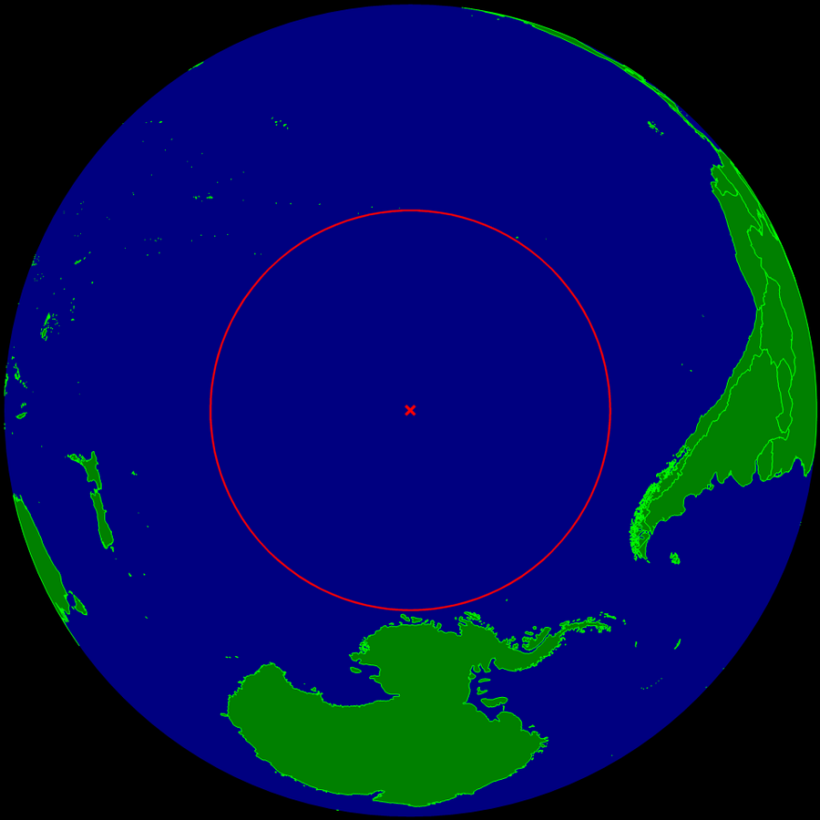In an unconventional quest, British explorer Chris Brown aims for the furthest point from civilization: Point Nemo, Earth's loneliest spot. Positioned deep in the Pacific Ocean, Point Nemo hosts remnants of space debris, far from any land.
If he succeeds, Brown, a 62-year-old entrepreneur, would be the first Briton to reach this remote destination, expressing his anticipation with plans for a celebratory toast upon arrival.

(Photo : Wikimedia Commons/Timwi)
The Quest for Point Nemo and Earth's Most Remote Oceans
Mr. Brown and his 32-year-old son, Mika, departed from Puerto Montt, Chile, aboard the Hanse Explorer, a chartered expedition yacht, on March 12. They aim to reach Point Nemo by March 20 or 21, weather permitting.
Although Mr. Brown initially considered using a racing yacht for speed, he opted for the safer choice of a sturdier vessel. The luxury yacht, typically used for tourist expeditions to Antarctica, agreed to alter its route for the Browns' expedition after negotiations with the owners.
Their destination, the Oceanic Pole of Inaccessibility, lies at the farthest point from land, with Ducie Island, part of the Pitcairn Islands, being the nearest landmass 1,670 miles (2,688km) away. Despite the extreme remoteness, Mr. Brown remains undeterred, aspiring to become the first to reach all eight of Earth's Continental Poles of Inaccessibility, the farthest points from any ocean.
Having conquered five of these poles already, including those in Antarctica, Oceania, Africa, North America, and South America, Mr. Brown downplays the danger of this expedition compared to his ventures in Africa and Antarctica. However, he acknowledges the potential risks of being isolated at sea and far from shipping lanes in case of emergency.
During a previous Antarctic expedition, Mr. Brown and his son faced a brief ordeal when their plane malfunctioned, leaving them stranded in frigid temperatures. Despite his adventurous spirit, Mr. Brown exercises caution, evident in his decision to decline a spot on a Titanic submarine expedition due to safety concerns regarding the piloting controls.
In addition to their exploration goals, Mr. Brown plans to collect water samples from Point Nemo to assess microplastic density in the world's most remote oceans. Point Nemo serves as a convergence zone for various ocean currents, leading to the accumulation of space debris and marine waste.
Despite its desolate nature, Point Nemo supports minimal life forms, with scientists discovering only bacteria and small crabs near the ocean floor vents.
READ ALSO: Is Dumping Old Spacecraft in Point Nemo A Good Idea? Why Are Environmentalists Against It?
Point Nemo: Earth's Satellite Graveyard and the Quest for Safe Disposal
The remoteness of Point Nemo has made it a prime destination for international space agencies to dispose of falling space debris. Global space programs have intentionally sunk nearly 300 retired craft, such as space stations and satellites, into the ocean at Point Nemo since the 1970s.
NASA's recent announcement to retire the International Space Station (ISS) by 2031 will add the largest spacecraft to the space graveyard at Point Nemo, weighing 925,335 pounds and measuring 357 feet long.
While sinking spacecraft into the ocean may seem extreme, leaving them in orbit perpetually poses risks of collision and subsequent fragmentation, as explained by Stijn Lemmens, a space debris analyst with the European Space Agency. Point Nemo, with its remote location and absence of human activity, serves as an ideal resting place for retired spacecraft.
Despite some spacecraft burning up upon re-entry into Earth's atmosphere, larger objects like the ISS require a controlled descent to ensure safe disposal. Point Nemo, along with two other oceanic sites, offers a wide expanse of uninterrupted ocean, facilitating the safe landing of spacecraft.
RELATED ARTICLE: Point Nemo's 'Space Cemetery:' Here's How International Space Station's Grave Would Look Like
Check out more news and information on Point Nemo in Science Times.














